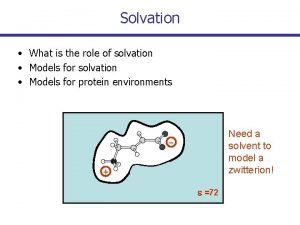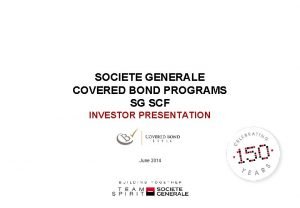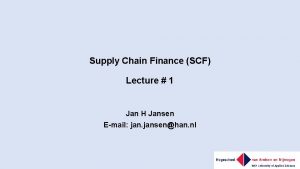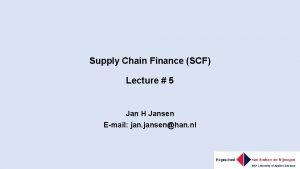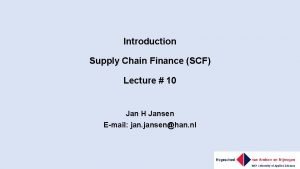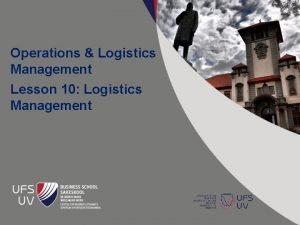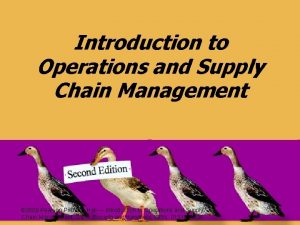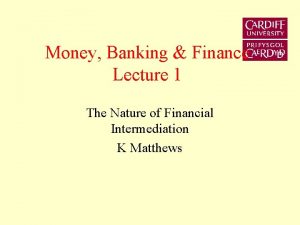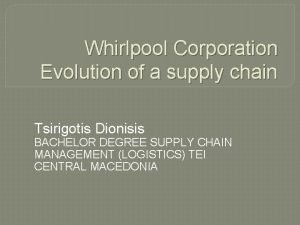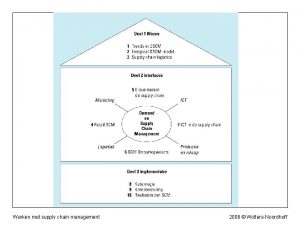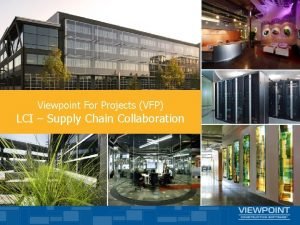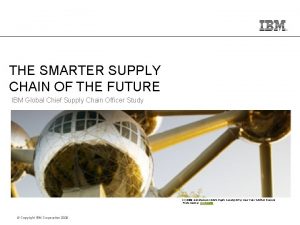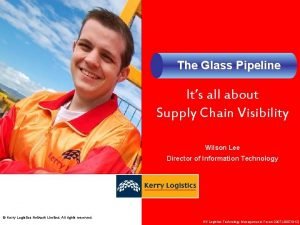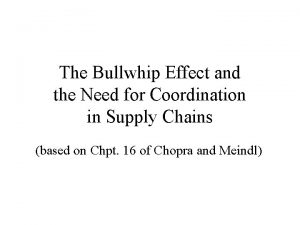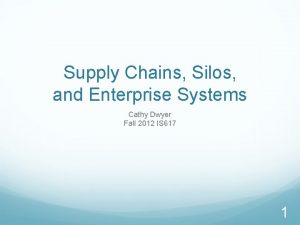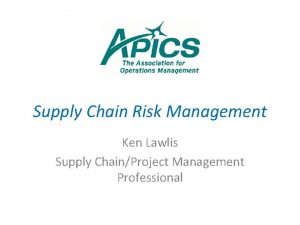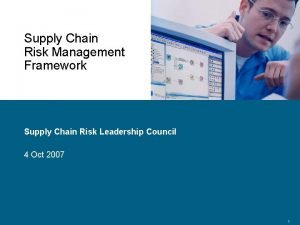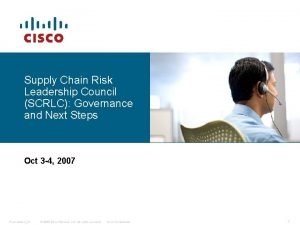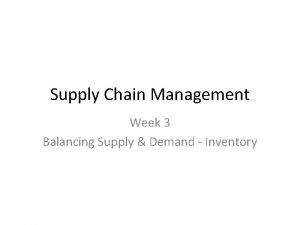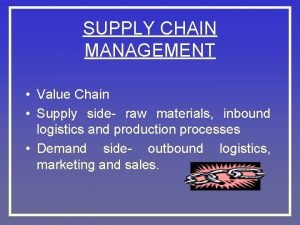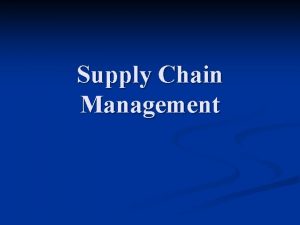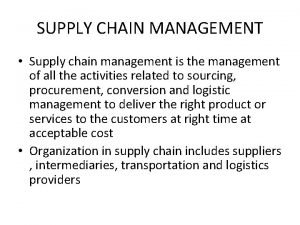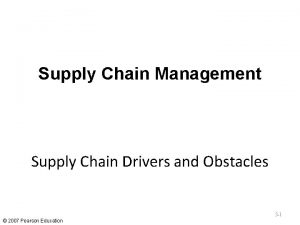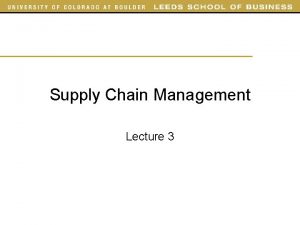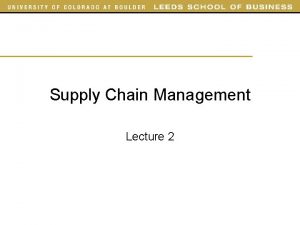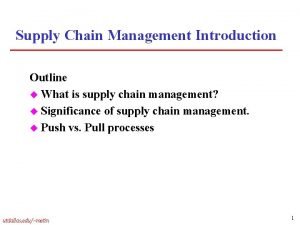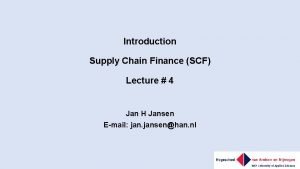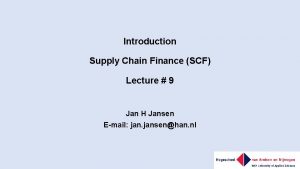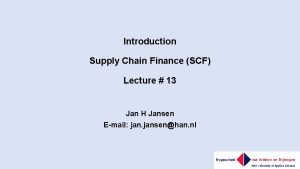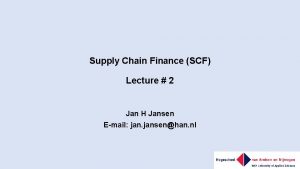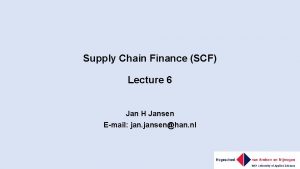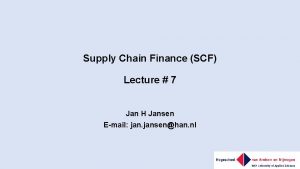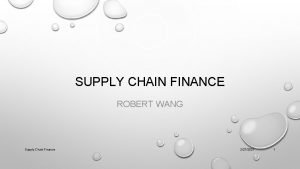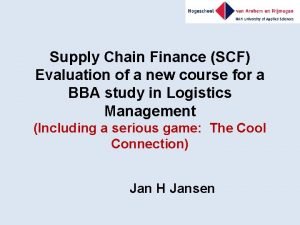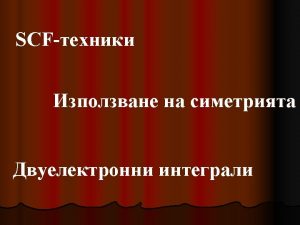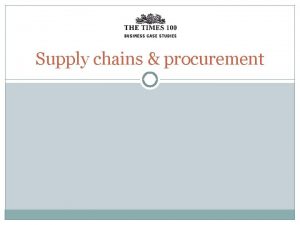Introduction Supply Chain Finance SCF Lecture 12 Jan







































- Slides: 39

Introduction Supply Chain Finance (SCF) Lecture # 12 Jan H Jansen E-mail: jansen@han. nl

Round # 5 The Cool Connection

Lectures period 2 or 4 Lecture Topic Preparation 8 Introduction to value Cool connection round 1 Assignment 6 9 CAPM & EVA Cool connection round 2 Assignment 7 10 SCF instruments Cool connection round 3 Assignment 8 EBA SCF 11 Blockchain in SCM & SCF Cool connection round 4 Cool connection round 5 Cool connection round 6 Cool connection round 7 Test exam Case Heineken 12 13 14 Case Unilever Case Philips Test exam Exam case

Levels of SCF instruments Strategic • Take over • Joint venture • Minority interest Tactical • Equipment financing • Pay on production • Supply risk sharing • Currency risk sharing Operational • Working capital • Reverse factoring • Dynamic discounting • Inventory financing • Purchase order financing Source: SCF, its practical relevance and strategic value, Boer de, R. et al, SCF Community, 2015 (adapted by the author)

Recent contribution in SCF An exploratory study into supply chain finance: The relevance of supplier segmentation Steeman, M. A. et al. , 2015, Paper Vervoerslogistieke Werkdagen, University Press (Zelzate)

Supply chain finance instruments • • Equity / Joint venture / Minority stake Reversed factoring Long-term loans Vendor managed inventory (VMI) Buyer manager inventory / Tolling / Natural hedging Dynamic discounting Contractual risk / profit sharing

Research outcome Strategic Equity Long-term loans Contractual profit/risk sharing Advance payments Operational Dynamic discounting Vendor managed inventory (VMI) Reversed factoring

Recap Lecture 11 Blockchain in Logistics

Blockchain Financial Cypto currencies Nonfinancial Energy Bitcoin Logsitics data Ethereum Etc. Altcoins



Source: http: //www. blockchain-lab. org/#publications


About Maersk A. P. Moller - Maersk is an integrated container logistics company working to connect and simplify its customers’ supply chains. As the global leader in shipping services, the company operates in 130 countries and employs roughly 76, 000 people. For more information about Maersk, visit maersk. com or follow us on Twitter at @maersk. About IBM is the leader in open-source blockchain solutions built for the enterprise. As an early member of Hyperledger and active contributor to the Hyperledger Fabric and Stellar blockchain projects, IBM is dedicated to advance cross-industry blockchain technologies supporting the development of openly-governed transactional business networks. IBM has worked with more than 400 clients across financial services, supply chains, Io. T, risk management, digital rights management and healthcare to implement blockchain applications. For more information about IBM Blockchain, visit ibm. com/blockchain. Source: https: //www. maersk. com/news/2018/06/29/maersk-and-ibm-introduce-tradelens-blockchain-shipping-solution

New business models unlock value we. trade brings together fierce banking rivals to create new business value in offering liquidity to small and medium-sized businesses. https: //www. youtube. com/watch? v=1 Zgz 28 tk. V 0 w

Source: https: //www. maersk. com/news/2018/06/29/maersk-and-ibm-introduce-tradelens-blockchain-shipping-solution

Source: https: //www. maersk. com/news/2018/06/29/maersk-and-ibm-introduce-tradelens-blockchain-shipping-solution

Lecture 12 Case study

Questions 1. Why is supply chain finance for Unilever so important? 2. Why is supply chain finance for Unilever’s Tier 1 & Tier 2 suppliers so important?


Source: https: //www. google. com/finance? q=OTCMKTS%3 AHINKY&ei=ARs 6 V 4 Pz. Lca 4 U_Wnl. ZAL

Ticker symbol UL PG Company name Unilever(ADR) Procter & Gamble Co

Case Unilever • SCF Forum (10 -12 -2014) • Jean-Christian Dumas • Senior Procurement Finance Manager /Business Controller at Unilever

Source: Annual Report 2014 Unilever

Our growth model is enabled by a leaner, fitter, more agile Unilever, with costs being reduced through our supply chain efficiency programmes. These have been boosted by our low-cost business model initiative, which has delivered € 450 million of savings since 2011. Source: Annual Report 2014 Unilever

The USLP is embedded into our business model. It helps to drive long-term shareholder value by: driving growth through innovations that bring new sustainability benefits to consumers and retailers; reducing waste and energy and thereby saving cost; and managing risk in our supply chain, for example by securing long-term sustainable sourcing of materials. Source: Annual Report 2014 Unilever

SUPPLY CHAIN Our business depends on purchasing materials, efficient manufacturing and the timely distribution of products to our customers. Our supply chain network is exposed to potentially adverse events such as physical disruptions, environmental and industrial accidents or bankruptcy of a key supplier which could impact our ability to deliver orders to our customers. The cost of our products can be significantly affected by the cost of the underlying commodities and materials from which they are made. Fluctuations in these costs cannot always be passed on to the consumer through pricing. Source: Annual Report 2014 Unilever

Finance Source: Annual Report 2014 Unilever

Source: Annual Report 2014 Unilever







Recent contribution in SCF Redraw the map to reduce suppliers’ finance costs, by Professor Michiel Steeman http: //www. scfbriefing. com/viewpoint-redraw-themap-to-reduce-suppliers-finance-costs/



Quadrant 4: Contract farming In this model, where finance costs are high across the supply chain, the large buyer purchases the seeds, fertiliser and all the other things needed by a farmer who then becomes a contract manufacturer. The buyer keeps ownership of the produce throughout the supply chain. This is a model often seen in developing countries, for example, where much of the supply chain is financially weak. These farmer/suppliers’ margins may be smaller under this model than they otherwise would be, and the profit upside is more limited as farmers have less opportunity to deal with other buyers; they are more tied in to just the one supply chain. But they benefit from having a more certain income stream, relieving them of the downside risk.
 Scf ttm
Scf ttm Fsu.instructure
Fsu.instructure Socgen investor relations
Socgen investor relations Polyself.xyz paradigm
Polyself.xyz paradigm Standard definitions for techniques of supply chain finance
Standard definitions for techniques of supply chain finance Standard definitions for techniques of supply chain finance
Standard definitions for techniques of supply chain finance Matching supply with demand
Matching supply with demand Difference between logistics and supply chain
Difference between logistics and supply chain Sequence of food chain
Sequence of food chain Introduction to operations and supply chain management
Introduction to operations and supply chain management Introduction to operations and supply chain management
Introduction to operations and supply chain management 01:640:244 lecture notes - lecture 15: plat, idah, farad
01:640:244 lecture notes - lecture 15: plat, idah, farad Indirect finance
Indirect finance Switch mode power supply lecture notes
Switch mode power supply lecture notes Chapter 5 section 1 supply and the law of supply
Chapter 5 section 1 supply and the law of supply Ang elastisidad ng supply ay?
Ang elastisidad ng supply ay? Introduction to biochemistry lecture notes
Introduction to biochemistry lecture notes Introduction to psychology lecture
Introduction to psychology lecture Introduction to algorithms lecture notes
Introduction to algorithms lecture notes Whirlpool corporation evolution of a supply chain
Whirlpool corporation evolution of a supply chain Werken met supply chain management
Werken met supply chain management Viewpoint for project collaboration
Viewpoint for project collaboration Contemporary management practices
Contemporary management practices Ibm supply chain strategy
Ibm supply chain strategy Pipeline in supply chain
Pipeline in supply chain Incentive obstacles in supply chain
Incentive obstacles in supply chain Supply chain silos
Supply chain silos Supply chain risk register
Supply chain risk register Supply chain risk management framework
Supply chain risk management framework Supply chain risk management framework
Supply chain risk management framework Risk assessment likelihood
Risk assessment likelihood Supply chain risk leadership council
Supply chain risk leadership council Reorder point formula
Reorder point formula Value chain structure
Value chain structure Supply chain management is the management of the
Supply chain management is the management of the Supply chain it framework
Supply chain it framework Drivers of supply chain management
Drivers of supply chain management Netflix supply chain
Netflix supply chain Push pull in supply chain
Push pull in supply chain Replenishment cycle in supply chain
Replenishment cycle in supply chain
